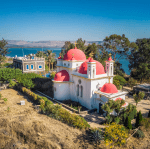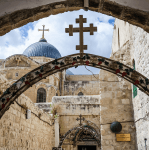Христианские святыни в Иерусалиме и округе
Храм Гроба Господня
Расположенный в христианском квартале Старого Города в Иерусалиме, около 70 км к западу от Тель Авива, Храм Гроба Господня (также известен как Храм Воскресе́ния Христо́ва) включает два из наиболее святых для христианства мест: место распятия Иисуса (Голго́фа, на греческом или Кальва́рия, на латинском), а также гробница, где, согласно вере, Иисус был похоронен, а затем воскрес.
Также в храме происходили четыре последних этапа пути Иисуса по улицам Иерусалима, несущего крест до момента своего распятия (Крестный путь).
Первый, известный историкам храм на этом месте был построен римским императором Константином Великим в 325 году н.э.
На протяжении веков место развивалось и преобразилось в потрясающий комплекс, который мы видим сейчас.
Храм управляется несколькими христианскими конфессиями благодаря ряду договорённостей и соглашений, которые были заключены более 160 лет назад.
Каждый день в храме происходит впечатляющая и волнующая процессия, начинающаяся и завершающаяся у капеллы Святых Даров. Она проходит через 14 стояний, представляющих собой воспоминание эпизодов крестного пути Иисуса Христа, при которых служители зачитывают вслух или поют гимн.
Далее приведён список 14-ти стояний:
- I: Господа Иисуса осуждают на смерть (капелла Святых Даров)
- II: Иисус берёт крест на свои плечи (“Столп бичевания Христа”)
- III: Иисус падает в первый раз (Тюрьма Иисуса Христа)
- IV: Иисус встречает свою Мать по пути на Голгофу ()
- V: Симон Кириниянин помогает Христу нести крест
- VI: Св. Вероника отирает лицо Господу Иисусу
- VII: Иисус падает второй раз
- VIII: Иисус Христос обращается к женщинам Иерусалима.
- IX: Иисус падает третий раз.
- X: Иисуса Христа обнажают.
- XI: Иисуса пригвождают к кресту.
- XII: Иисус умирает на кресте.
- XIII: Иисуса снимают с креста.
- XIV: Погребение Иисуса Христа.
В Иерусалиме также имеются многие другие святые для христианства места. Далее приведены некоторые из самых примечательных:
- Виффагия
- Церковь Святого Иоанна Крестителя
- Храм Вознесения на Елеонской горе
- Храм Успения Пресвятой Богородицы
- Виа Долороза (путь скорби)
Иерихон
Оазисный город Иерихон, находящийся в 100 км от Тель Авива, в 35 км от Иерусалима и 258 м ниже уровня моря, расположен на территории, управляемой Палестинской Национальной Администрацией.
Находящийся вблизи реки Иордан и богатый пресноводными источниками, город известен своей плодородной землёй и финиковыми пальмами.
Город считается одним из древнейших в мире, с историей, начинающейся более 10,000 лет назад, с 8,000 года до н.э. Он неоднократно упоминается в Старом и Новом Заветах.
Одним из главных источников доходов города является христианский туризм, благодаря некоторым важнейшим для христианства местам в самом городе и его окрестностях.
Среди них числятся:
- Гора Искушения (Каранталь), на которой расположен греческий православный монастырь (360 м над уровнем моря). Гора Искушения традиционно почитается как место, на котором по преданию, Христа Спасителя искушал дьявол на протяжении сорокадневного поста.
- Источник пророка Елисея, где пророк Елисей, по преданию, очищал источник, бросая в него соль.
- Платановое дерево Закхея (евангелие от Луки 19:1-10).
- Традиционное место крещения Христа в Каср аль-Яхуд на берегу реки Иордан.
- Монастырь Герасима Иорданского
- Монастырь Святого Георгия
Капелла бичевания Христа и Церковь Осуждения и Возложения Креста
В 100 км от Тель Авива, в Старом Городе Иерусалима, мы можем посетить капеллу бичевания Христа. Она размещена на территории, прилегающей к францисканскому монастырю, и в ней находятся два места, имеющие отношение к смерти Христа.
Капелла бичевания, где Иисус был подвергнут бичеванию римских легионеров, и церковь Осуждения и Возложения Креста, где он был приговорён к распятию Понтием Пилатом, после того, как, накинув на Иисуса лохмотья красного плаща и водрузив на голову колючую ветку терновника, возложили на Него крест и он отправился в свой последний путь Страданий по дороге к Искуплению.
Капелла бичевания была построена в 1929 году. Дизайн интерьера включает купольный потолок, колючую ветку терновника и окна капеллы вокруг главного алтаря, запечатляющие разбойников, которые были очевидцами казни Иисуса.
Церковь Осуждения и Возложения Креста была изначально построена в период правления Византийской империи. Затем, когда Иерусалим находился под властью мусульман, она превратилась в монастырь.
К началу 20-го века она снова была освящена в качестве церкви и полностью обновлена в 1904 году.
На сегодняшний день эта красивейшая капелла имеет пять бриллиантово-белых куполов, каждый из которых опирается на ряд захватывающих дыхание витражей и множество восхитительных фигур из папье-маше, воплощающие Страсти Христовы.
Вифлеем – поле пастушков и грот
Когда Господь объявил о прибытии Иисуса Христа, он обращался не к людям из высшего сословия, а к простым пастухам (одно из наименее благоприятных ремесел в ту эпоху), ведущим свои стада по полям и пещерам в окрестностях городка, известного как Бейт-Сахур, пригород Вифлеема (евангелие от Луки 2:8-10).
На сегодняшний день, это место (около 80 км от Тель Авива и 30 км от Иерусалима) является частью территории, управляемой Палестинской Национальной Администрацией, но всё же посещается многими христианскими туристами и паломниками.
Что касается других святых мест, то в Вифлееме находятся два места (на расстоянии всего лишь в 600 м друг от друга), известные тем, что по преданию, именно в них было объявлено о прибытии Иисуса.
В обоих местах, одно находящееся под надзором греческой православной церкви, а второе – под надзором францисканцев, находились церкви и монастыри с 4-го века н.э.
Францисканский монастырь имеет капеллу, дизайн которой напоминает палатку пастуха.
На месте, находящемся под надзором греческой православной церкви, находится церковь 5-го века, построенная над пещерой, которая была использована в качестве пункта поклонения с 325 года н.э. когда Святая Елена основала здесь первую церковь.
Храм Рождества Христова
Храм Рождества Христова почитается как место рождения Иисуса. Оно ассоциируется с пещерой, над которой Святой Еленой была построена и освящена в 339 году н.э первая церковь, признанная одним из самых святых христианских мест.
На протяжении веков, Храм Рождества Христова был подвергнут многим изменениям различными правителями. Однако, все они, в такой или иной мере, признали святость этого места и воздерживались от разрушения построенных там церквей.
Несмотря на это, то, чего не поднялась совершить рука человека, было совершенно природой, когда в 1834 году землетрясение, а в 1869 и 2014 годах пожары, уничтожили бо́льшую часть интерьера церкви 6-го века н.э, но само здание осталось невредимым.
С 1852 года, Римская католическая, Армянская, Сирийская и Греческая православная церкви успешно осуществляют совместный надзор над этим местом, при том, что каждая из них ответственна за иные части комплекса.
Тут можно отметить интересный факт: точное место рождения Иисуса Христа отмечено серебряной звездой, вделанной в пол грота Храма Рождества Христова.
Эта оригинальная звезда была украдена в 1847 году, в результате разногласий с правителями Османской империи по поводу доступа христиан к святым местам, приведших к Крымской войне (1854-1856).
Вифлеем находится неподалёку от Иерусалима и предоставляет всем желающим возможность посетить многие христианские места.
Так как не имеется возможности перечислить их всех из -за большого количества, далее приведены некоторые из них:
- Храм Гроба Господня
- Церковь Иоанна Крестителя
- Храм Вознесения на Елеонской горе
- Храм Успения Пресвятой Богородицы
- Виа Долороза (путь скорби)
Виффагия
Церковь Виффагии отмечает то место, которое, согласно преданию, является начальной точкой триумфального входа Иисуса Христа в Иерусалим, который на сегодняшний день мы празднуем как день Входа Госпо́дня в Иерусали́м (евангелие от Матфея 21:1-11).
Францисканская церковь, отмечающая это событие, находится в Иерусалиме, на восточном склоне Масличной Горы рядом с Вифанией, где Иисус воскресил Лазаря из мёртвых (евангелие от Иоанна 11:1-44).
Вот откуда начинаются ежегодные традиционные церемонии, посвящённые Входу Госпо́дню в Иерусали́м.
Внутри церкви, над алтарём, мы находим потрясающую стенопись, воплощающую Иисуса, въезжающего верхом на осле в Иерусалим, где его встречает народ.
В церкви также вы увидите большущий камень, ограждённый литыми железными перилами. Крестоносцы считали его камнем, используемым Иисусом для того, чтобы сесть на осла.
Однако, некоторые исследователи и историки скептически относятся к подобному аргументу, так как высота камня более соответствует боевым коням крестоносцев, чем смиренному ослу.
Грани камня украшены средневековыми картинами, изображающими приверженцев, толпу с пальмовыми ветвями и воскресение Лазаря, величие которых было придано им вновь в 1950 году.
Вифлеем находится неподалёку от Иерусалима и предоставляет всем желающим возможность посетить многие христианские места.
Церковь Посещения Пресвятой Девы Марии– Эйн Керем, Иерусалим
В 66 км от Тель Авива и всего лишь в 7 км от Старого Города Иерусалима, находится церковь Посещения Пресвятой Девы Марии в живописном районе Эйн Керем.
Церковь связывает нас с евангельским эпизодом посещения Девой Марией своей родственницы Елизаветы (евангелие от Луки 1:56). Обе женщины имели младенцев в чревах, Иисус у Марии и Иоанн Креститель у Елизаветы (Иоанн родился в Эйн Кереме).
Согласно традиции, нерождённый Иоанн опознал нероджённого Иисуса и взыграл радостно в утробе матери (евангелие от Луки 1:44).
После этого чудотворного события, Дева Мария возвела славословие Господу – более известное как “Магнификат”.
Знакомая нам на сегодняшний день церковь была завершена в 1955 году и построена на восстановленных руинах более низкой церкви, которая была построена в 1862 год на месте Византийской церкви крестоносцев над гротом, где когда-то находился небольшой источник.
Интерьер верхней церкви щедро украшен многими стенописями и фресками, изображающими жизнь Девы Марии и её постепенное становление центральной личностью в христианской вере.
Нижняя церковь содержит фрески, изображающие других женщин, упомянутых в Библии благодаря своим славословиям.
Во внутреннем дворе церкви одна из стен оснащена керамическими плитками со словом “Магнификат” на 42 различных языках.
Церковь Иоанна Крестителя – Эйн Керем, Иерусалим
Комплекс церкви расположен над гротом, почитающемся как местом рождения Иоанна Крестителя, именуемого как “Предтеча”, ибо именно он крестил Иисуса и провозгласил его в качестве Мессии.
Как многие другие святые места, церковь имеет богатую историю построений и разрушений.
Первая церковь была построена здесь в период правления Византийской империи около 500 года н.э. Здесь находятся руины двух капелл (капелла Мучеников и ещё одна капелла под южной стороной монастыря). Обе были разрушены во время восстаний самаритян в 529 и 556 годах н.э.
Члены Ночного Ордена Госпитальеров заново построили капеллу в 1104 году, назвав её в честь Иоанна Крестителя, когда крестоносцы завоевали Иерусалим.
Однако, сооружение было разрушено в 12-ом веке н.э и остались лишь её руины вплоть до конца периода правления Османской империи.
Во времена Турецкого (Османского) правления францисканские монахи (примерно с 1670 года) начали приобретать земельные участки в этом месте и его окрестностях.
Монастырь был освещён в 1895 году и существующая на сегодняшний день церковь была завершена в 1920 году.
Вам стоит посетить монастырь и церковь, богатые содержащимися в них фресками, плитными стенами и витражами.
Монастырь святого Иоанна в пустыне – Эйн Керем, Иерусалим
В отличии от своего названия, монастырь расположен на пышных, зелёных холмах Эйн Керема, всего лишь в 7 км от Старого Города Иерусалима. Так почему же всё-таки монастырь “в пустыне”?
Согласно евангелию от Луки (1:80), Иоанн Креститель проживал аскетом/отшельником в пустыне, пока судьба его не выявилась перед ним.
В те времена, деревня Эйн Керем (где родился Иоанн) и её окрестности Иудейских гор выглядели совершенно иначе, чем сегодня, и были достойны называться пустыней или дикой местностью.
Сегодня Монастырь святого Иоанна в пустыне окружён лесами и растительностью, и пресноводный источник наполняет пруд с множеством морских окуней.
Территория монастыря богата тропинками и проходами, вырезанными в камне.
Некоторые из них ведут к двум пещерам, в одной из который находится источник для крещения и ритуалов очищения.
Вторая считается пещерой, в которой родители Иоанна, Захария и Елизавета прятались с юным Иоанном от Избиения младенцев, начавшегося по распоряжению царя Ирода.



